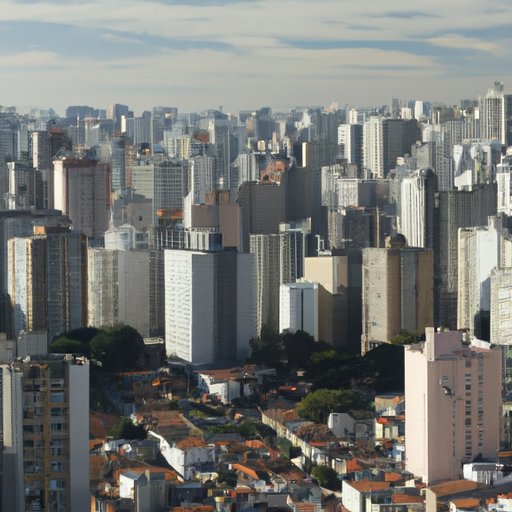Introduction
What is the most populated city in the world? This is a question that has been asked since ancient times, as people have sought to understand the dynamics of population growth and urbanization. In this article, we will explore the definition of the most populated city, compare the world’s largest cities by population, examine historical trends in urbanization, and investigate the factors behind a city’s population boom. We will also take a closer look at the challenges faced by the most populated city and how these can be addressed.
Comparison of World’s Most Populated Cities
According to the United Nations, Tokyo is the most populated city in the world, with a population of 37 million people. It is followed by Delhi (29 million), Shanghai (26 million), Sao Paulo (21 million), and Mexico City (20 million). Other major cities include Mumbai (19 million), Osaka (19 million), Cairo (18 million), New York City (18 million), and Beijing (17 million).
When considering the world’s most populated cities, it is important to keep in mind that population size is influenced by many factors. These include geography, climate, infrastructure, economic opportunities, quality of life, and access to resources.
How Mega-Cities Have Grown Over Time
Urbanization – the process of people moving from rural to urban areas – has been occurring for centuries. In 1800, only 3% of the world’s population lived in cities; by 1950, this had increased to 29%, and today, more than half of the world’s population lives in cities. This rapid growth has resulted in the emergence of mega-cities, or cities with populations of 10 million or more.
Over the past two centuries, the rate of population growth has varied significantly between countries. For example, while some countries have experienced dramatic population growth, others have seen a steady decline or even negative growth. The reasons for this vary, but can include war, famine, disease, and economic downturns.

Exploring the Social and Economic Impact of Urbanization
Urbanization has had both positive and negative effects on society. On the one hand, it has enabled people to access better education, healthcare, and employment opportunities. On the other hand, it has led to overcrowding, pollution, and other problems. These issues can be particularly acute in large cities, where the demand for housing, services, and infrastructure often outstrips supply.
In addition, urbanization can have an impact on local cultures and economies. For instance, it can lead to the displacement of traditional communities, the destruction of natural habitats, and the erosion of local customs and identities. It can also disrupt existing economic systems, as new businesses and industries are established to meet the needs of the growing population.

An Overview of the Largest Metropolitan Areas in the World
Metropolitan areas are geographical regions that contain multiple cities and their surrounding suburbs. The world’s largest metropolitan area is Tokyo, which is home to 38 million people. Other major metropolitan areas include Delhi (25 million), Shanghai (23 million), Sao Paulo (22 million), and Mexico City (21 million).
When looking at the world’s largest metropolitan areas, it is important to consider the factors that contribute to their population growth. These include job opportunities, cultural attractions, access to amenities, and the presence of universities and other educational institutions.
Examining the Challenges Faced by the Most Populated City
Cities with large populations face a variety of challenges, including overcrowding, pollution, traffic congestion, and poverty. In order to address these issues, governments must implement effective policies and strategies. These can include initiatives to improve public transportation, reduce air and water pollution, and encourage sustainable development.
In addition, citizens must be educated about the importance of conservation and responsible resource management. This includes reducing energy consumption, reusing materials, and recycling. By taking these steps, cities can become more livable and sustainable.
Investigating the Factors Behind a City’s Population Boom
When examining why a city experiences a population boom, it is important to consider the economic, social, and cultural factors that attract people. Economic opportunities, such as jobs and investment, can draw people from other areas. In addition, cities can offer a range of social and cultural attractions, such as museums, restaurants, and festivals.
When a city becomes attractive enough, it can experience a “tipping point” in terms of population growth. At this point, the city becomes increasingly attractive to newcomers, leading to further growth and development.
A Study of the Most Populated City: What Makes it Unique?
Tokyo is the most populated city in the world, and it is unique in many ways. It is a vibrant and cosmopolitan city, with a rich history and culture. It is also a center of innovation, with cutting-edge technology and research. In addition, the city has excellent public transportation and a robust economy.
These characteristics make Tokyo an attractive destination for people from all over the world. It is a place where people can find opportunity, pursue their dreams, and explore new possibilities.
Conclusion
In conclusion, Tokyo is the most populated city in the world, and understanding its impact on urbanization is essential for addressing the challenges faced by large cities. Population growth is influenced by a range of factors, including geography, climate, infrastructure, economic opportunities, and quality of life. Urbanization can have both positive and negative effects on society, and it is important to consider the social and economic impacts of large-scale population growth. Finally, cities can become attractive destinations due to their economic, social, and cultural offerings.
By studying the world’s most populated city, we can gain insights into the dynamics of population growth and urbanization. This knowledge can help us to develop strategies to address the challenges posed by large-scale urbanization and ensure that cities remain livable and sustainable places for future generations.


